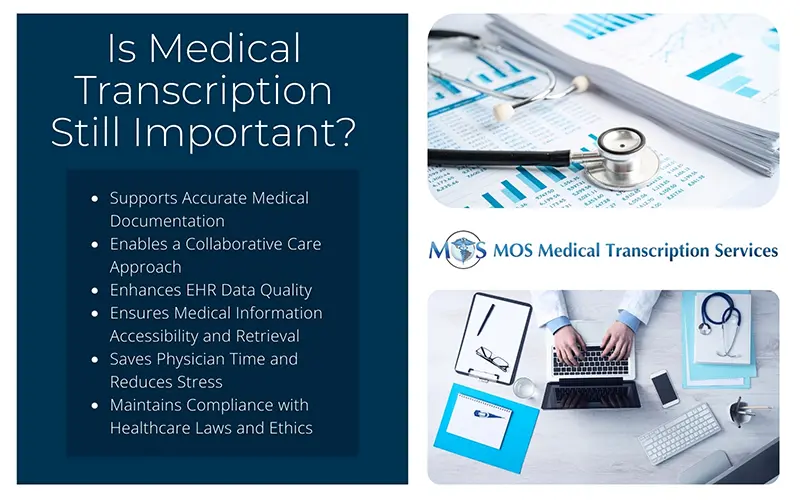
Table of Contents
The practice of creating and maintaining medical records has undergone a significant transformation over the years. Initially, clinical documentation consisted of handwritten notes by physicians. As healthcare delivery became more complex, this gave way to analog recordings of physician dictation captured on tapes using manual recording equipment. To convert these voice recordings containing critical patient information into accurate, readable documentation, medical transcription services emerged. Trained transcriptionists played a key role in transforming spoken clinical details into structured, reliable medical records.
Evolution of Medical Transcription in the Digital Age
Today, digital tools and software play a key role in helping physicians and medical transcriptionists generate accurate and timely patient records. The healthcare transcription process is now largely digital, leveraging advanced speech recognition software, secure cloud-based platforms, and electronic health record (EHR) integration. Physicians dictate their notes using digital devices or mobile apps, which are then transcribed either automatically or by trained medical transcriptionists who review them for accuracy. Transcriptionists often use speech recognition software to streamline the process. The software first converts physician dictation into text. Transcriptionists then review, edit, and proofread the generated text to correct errors, ensure medical accuracy, and maintain formatting standards. The final transcripts are securely uploaded to the patient’s EHR, ensuring timely, accurate, and compliant digital health records.
Why Medical Transcription is Still Relevant Today
The importance of medical transcription in modern healthcare cannot be overstated. Even with the evolution of high-grade software and digital tools, many healthcare providers outsource transcription to ensure efficient medical record keeping. Accurate and complete medical records are essential for proper patient care, healthcare provider collaboration, legal compliance, medical billing, and research.
Supports Accurate Medical Documentation
Medical transcription ensures comprehensive and accurate documentation of patient encounters by converting physician dictations into clear, structured medical records. A wide variety of clinical reports dictated by healthcare providers are transcribed, such as. History and Physical (H&P), consultation, operative, progress notes, discharge summaries, and imaging reports. Accurate and detailed medical records are crucial for ensuring patient safety, effective treatment, and proper healthcare administration. Incomplete or inaccurate information can lead to misdiagnoses, inappropriate treatments, and even legal issues. By helping providers maintain accurate records, medical transcription ensures proper documentation practices and upholds the integrity of patient information.
By outsourcing the clinical documentation task, physicians can expect adherence to best practices that ensure:
- Real-time documentation
- Clarity and legibility
- Complete information
- Timely updates
By recording information correctly as it becomes available, transcriptionists help prevent errors and omissions.
Enables a Collaborative Care Approach
Medical transcription supports coordinated patient care, ensuring that care is delivered effectively and efficiently across different providers and settings.
Effective care coordination relies on accurate and readily accessible medical records to ensure seamless transitions and informed decision-making among healthcare providers. For example, for a patient with multiple chronic conditions, effective clinician collaboration can help ensure that medications are reconciled, appointments are scheduled appropriately, and that all providers are aware of the patient’s overall condition and treatment plan. Medical transcription supports efficient care coordination and safety by ensuring a central repository of the patient’s health information, including medical history, diagnoses, treatment plans, lab results, and more. Clear, well-formatted transcripts minimize the chances of misunderstanding among care teams, supporting better clinical decisions.
Enhances EHR Data Quality
Clinicians rely on precise data to make critical decisions about patient care. Medical transcriptionists help structure and clarify physician dictations, ensuring efficient EHR data entry for documentation of critical details. High-quality EHR data provides a complete overview of a patient’s medical background, facilitating better decision-making and evidence-based healthcare practices. High-quality data helps healthcare organizations adhere to regulations such as HIPAA and avoid penalties associated with data breaches and errors. By ensuring the accuracy and privacy of patient data, medical transcription builds trust in the healthcare system encourages patient engagement in their care.
Ensures Medical Information Accessibility and Retrieval
Access to accurate and complete medical records is crucial for patient care, legal processes, and research. Efficiently retrieving and documenting health information is essential in the fast-paced healthcare environment. Transcribed medical records are stored digitally within electronic record systems, allowing healthcare providers to access them quickly when needed. This ensures timely retrieval of patient information during consultations, emergencies, and follow-up visits, enhancing the overall efficiency and continuity of care.
In addition to current information, healthcare providers also need access to historical medical records. Medical transcription services ensure historical records, offering providers a clear picture of a patient’s previous illnesses, surgeries, medications, allergies, and responses to treatments. This information is critical to avoid redundant testing, prevent adverse drug interactions, manage chronic conditions effectively, and make informed decisions during emergencies.
Saves Physician Time and Reduces Stress
By handling documentation tasks, transcriptionists free up physicians to focus more on patient care rather than administrative work. Instead of spending hours typing notes or navigating complex EHR interfaces, physicians can dictate their observations and treatment plans, leaving the transcriptionists to convert them into accurate, formatted records. This allows physicians to devote more time and attention to patient interaction, diagnosis, and care delivery, improving both the quality of care and physician satisfaction. Medical transcription also helps reduce stress and burnout by relieving physicians of tedious documentation duties.
Maintains Compliance with Healthcare Laws and Ethics
Proper record-keeping is a legal obligation for healthcare providers. HIPAA-compliant medical transcription services ensure accurate, timely and confidential records that serve as evidence in case of legal disputes and protection against malpractice claims.

Why Medical Transcription Remains Indispensable
In today’s fast-paced, tech-driven healthcare environment, the importance of accurate, timely, and reliable clinical documentation remains unchanged. Medical transcription services continue to play a vital role by transforming physician voice recordings into structured records that support continuity of care, reduce physician burnout, and ensure compliance with legal and ethical standards. While tools like speech recognition have streamlined workflows, the expertise of trained transcriptionists remains essential for preserving the integrity of patient data and enhancing healthcare delivery.


